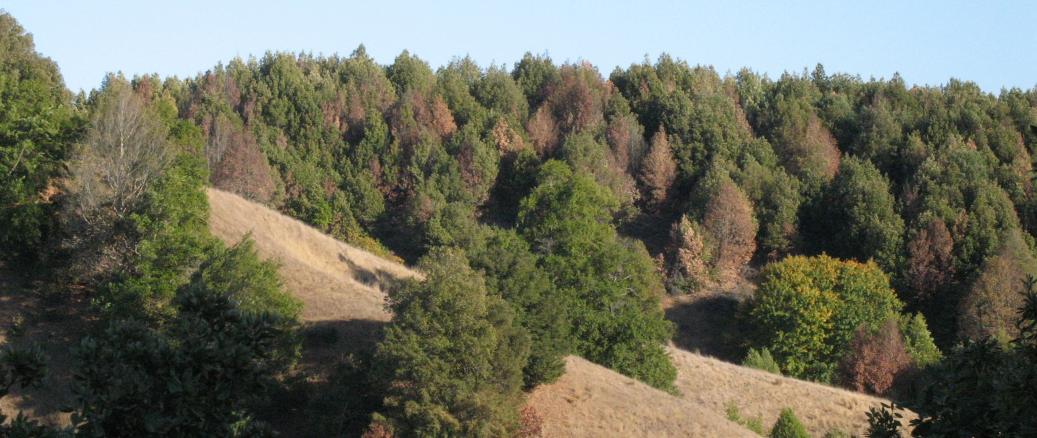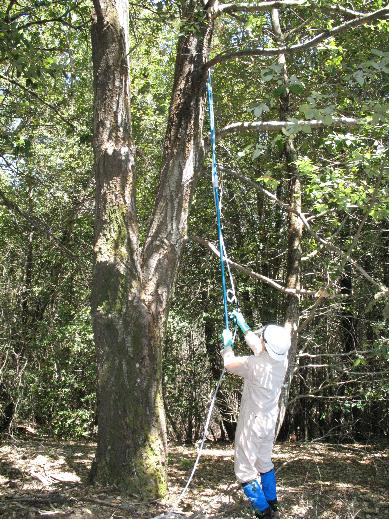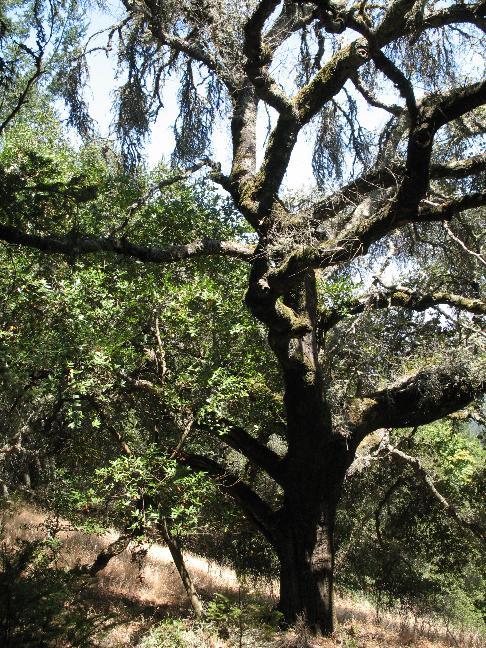Landowners and managers have been seeking ways to protect coast live oak (Quercus agrifolia), California black oak (Q. kelloggii), and tanoak (Lithocarpus densiflorus) from Phytophthora ramorum, the pathogen that causes sudden oak death (SOD), in both newly-infested areas and in areas that have been impacted by this disease for many years. Recent research has been used to formulate disease management strategies for minimizing the impacts of P. ramorum canker in susceptible stands of oaks and tanoak. However, neither short- nor long-term data are available to support the efficacy of these management techniques when applied in the field at a practical scale. In this collaborative project, we will establish a network of long-term disease management plots to test the efficacy of the most promising techniques for managing P. ramorum canker in forests containing tanoak, coast live oak, and black oak. To account for possible regional differences, plots will be distributed through much of the north to south range of P. ramorum in California’s Coast Ranges. Results of this project will be used to improve disease management recommendations and will provide additional information on the epidemiology of the disease in treated and untreated stands.
Phytosphere Research is currently seeking cooperators that have tanoak or oak stands that could be included in the studies described below. Please contact Ted Swiecki or Elizabeth Bernhardt at Phytosphere Research (phytosphere@phytosphere.com) if you are interested in participating in either study or if you need additional information. |
Disease management in tanoak stands using potassium phosphite (Agrifos)
Managing SOD in tanoak stands is difficult because P. ramorum can complete its entire disease cycle on this host alone. P. ramorum causes leaf and twig infections in tanoak that lead to dieback of the fine twigs. UC Davis researchers in Dr. David Rizzo's lab have shown that P. ramorum also produces spores on infected tanoak twigs. These spores cause additional twig infections and, in sufficient numbers, can initiate bark cankers on the main stems of tanoak. These cankers can girdle and kill entire trees.
Potassium phosphite (trade name Agri-fos) is a selective, systemic fungicide with a high level of environmental safety and very low non-target toxicity that has shown good levels of efficacy against P. ramorum canker in various trials. However, it has not been used widely enough in tanoak to determine the range of conditions under which it is effective. Furthermore, other questions remain as to the most effective way to utilize this material to manage P. ramorum canker in tanoak stands. Lab studies indicate that phosphite-treated tanoaks exhibited higher levels of resistance to artificial inoculations in the laboratory. By treating blocks of tanoak trees, it may be possible to not only prevent lethal bark cankers, but to also reduce twig infections, which should decrease spore production and disease spread overall. This study will test how effective phosphite is at reducing disease in tanoak when applied to a contiguous block of tanoaks.
Request for study cooperators
For this study, we are seeking locations that are close to or within areas where P. ramorum is present. However, since the treatment is primarily preventative in nature, most of the tanoak in the study plot areas need to be live and largely or completely lacking trunk cankers. We want to test the treatment in areas that are likely to have disease pressure, but where there is still a chance to prevent lethal trunk cankers. Preferably the actual plot areas (each plot will be roughly square and about 60 ft
on a side) will have little or no bay present. P. ramorum spores are also produced abundantly on infected bay leaves, but since bay are not being treated with phosphite in this study, the additional spores produced on bay would not be controlled by phosphite. The best alternative for dealing with this source of pathogen spores is simply to cut down bay within the plot. We will employ this treatment within the plots if only a few small bays are present, but large scale bay removal is beyond the scope of this study.
Phosphite will be applied as a spray to the trunk. For this to be practical, the plots
need to be fairly accessible and not terribly steep. At a given location,
we need to be able to set up at least 2 plots (1 treated, 1
control) separated by at least 25 ft in patches that are fairly comparable with respect to
tree density, size classes, and species composition. If the stand has a lot of
small understory tanoaks (less than about about 3 inch diameter), we will set up a third plot. It is impractical to treat very small understory tanoaks, but these seedlings and saplings can still serve as a
source of P. ramorum spores. In our treatment protocol, these small understory tanoaks are cut down and removed from the phosphite-treated plot and
from one control plot. A second control plot with no
understory tanoak removal is included as a check to determine whether removal of understory tanoaks alone can affect disease development within the plot.
The intent is that this study will go on for a number of years
(contingent upon funding), with phosphite being applied at about 1.5 year intervals. During the spring of the first year, we will be monitoring spore production within the plots; subsequent observations will evaluate disease development. |
Disease management in coast live oak and California black oak using selective removal or pruning of California bay
Disease epidemiology in oaks differs from that in tanoaks because the pathogen, P. ramorum, has not been shown to sporulate significantly on affected oak species (coast live oak, California black oak). Several lines of research indicate most infections on oaks are initiated by spores that are produced on infected California bay leaves. Recent research indicates that most of the disease risk in oaks is associated with bay that are quite close to or actually overtopping the oak trunk. This study investigates whether selective removal of bay from this small zone near the oak trunk is sufficient to reduce disease risk to an acceptably low level.
Request for study cooperators
This study is based on matched pairs of SOD-susceptible oaks (either coast live or California black oak). The trees within the pairs will be matched to the degree possible for known factors that influence disease risk, especially the amount of bay in the immediate vicinity of the trunk. One tree of each pair will have bay removed from the zone nearest to the trunk (about 10-15 ft). This will include removal of bay trees or branches as needed. The other tree from each pair will remain as is to serve as a control.
To avoid costs and other issues associated with the bay removal treatment, we are primarily looking for oaks that will require relatively little bay removal to make a large change in disease risk. Ideal oaks for treatment are those with only one to a few small diameter understory bays near the trunk. These situations commonly occur where bay is not the dominant tree in the stand. Removal of large overstory bays is beyond the scope of this study.
Locations considered for this study are areas which have P. ramorum present and causing symptoms on bay and possibly some oaks. Because this is primarily a preventive treatment, oaks should be free of obvious stem cankers. Bay removal treatments will be instituted in winter 2006-2007 and trees will be observed for a number of years afterward to determine whether treated oaks are less likely to develop SOD than untreated trees. |


